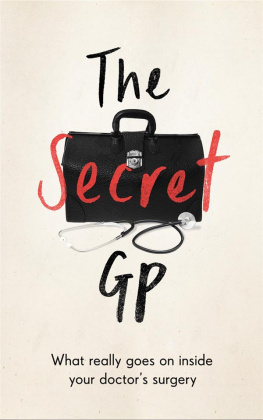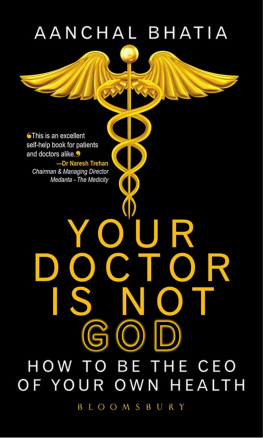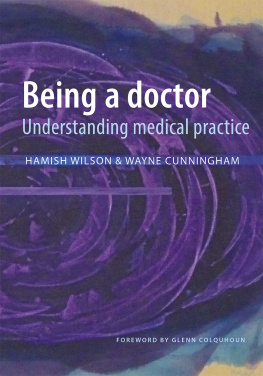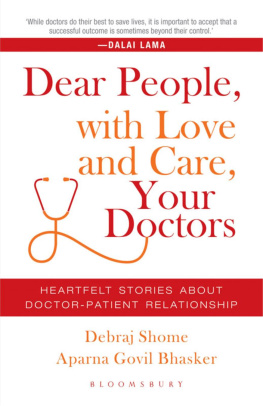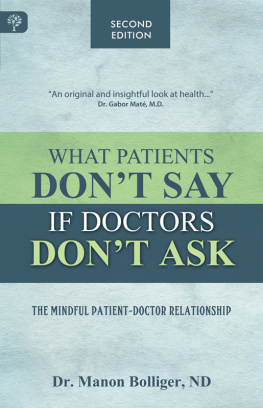Talking to Your Doctor
Talking to Your Doctor
A Patients Guide to Communication
in the Exam Room and Beyond
Zackary Berger
ROWMAN & LITTLEFIELD PUBLISHERS, INC.
Lanham Boulder New York Toronto Plymouth, UK
Published by Rowman & Littlefield Publishers, Inc.
A wholly owned subsidiary of The Rowman & Littlefield Publishing Group, Inc.
4501 Forbes Boulevard, Suite 200, Lanham, Maryland 20706
www.rowman.com
10 Thornbury Road, Plymouth PL6 7PP, United Kingdom
Copyright 2013 by Rowman & Littlefield Publishers, Inc.
All rights reserved. No part of this book may be reproduced in any form or by any electronic or mechanical means, including information storage and retrieval systems, without written permission from the publisher, except by a reviewer who may quote passages in a review.
British Library Cataloguing in Publication Information Available
Library of Congress Cataloging-in-Publication Data
Berger, Zackary, 1973
Talking to your doctor : a patient's guide to communication in the exam room and beyond / Zackary Berger.
p. cm.
Includes bibliographical references and index.
ISBN 978-1-4422-2050-8 (cloth : alk. paper) -- ISBN 978-1-4422-2051-5 (electronic)
1. Patient participation. 2. Physician and patient. 3. Communication in medicine. I. Title.
R727.42.B47 2013
610.69'6--dc23
2013014172
The paper used in this publication meets the minimum requirements of American National Standard for Information Sciences Permanence of Paper for Printed Library Materials, ANSI/NISO Z39.48-1992.
Printed in the United States of America
To my parents, my brother, my sister, and my in-laws
: !
,
, , : , , !
Acknowledgments
My agent, Anne G. Devlin, believed in the importance of this book, and she deserves my gratitude. I look forward to future adventures with her help. Suzanne Staszak-Silva has been a consummate editor, whose direction has immeasurably improved my attempts at clear prose.
My mentors, colleagues, and patients at Bellevue/NYU and Johns Hopkins, as well as at institutions elsewhere and in the wide world of social media, have taught me everything in this bookexcept for any mistakes, which I will cheerfully correct. I would name names, but then I would forget someone and never forgive myself. To all, then: consider yourself acknowledged, and redeem this acknowledgment for a beverage of your choice the next time we see each other. If you are my patient, I hope that our visits live up to the aspirations in this book.
Preface
The last time you went to your doctor, you might have emerged feeling dissatisfied and disoriented. What did you talk about together, after all? You didnt ask all the questions you wanted answers to, and you dont remember everything the doctor told you. What is the plan? How do we get there? Nothing was clear after you left the office, and you dont know whether its your fault or the doctors.
Maybe its your fault, or the doctors fault, or the blame can be laid at the feet of the entire health care system. But thats beside the point: the important thing is to identify the problem at the root of this experience and take steps to change it. Thats what this book does.
In Talking to Your Doctor, youll learn about the problems with doctor-patient encounters and the difficulties in communication that afflict many different kinds of people. Ive observed many thousands of encounters in my job as an internist at the Johns Hopkins Hospital, and use others fascinating research (together with some of my own) to point the way to a solution: strengthening the doctor-patient relationship through changes in our communication practices and the health care system.
Communicating well with our doctors isnt about being a good patient, obedient and docilebut it isnt just about being a passionate self-advocate either. Rather, it has to do with being clear about our wishes and expectations and becoming mindful to the complexities of the encounter.
In chapter 1, youll come along on my eye-opening experiences with doctor-patient communication as a resident doctor in New York City and a new attending physician in Baltimore. You will learn about frequent mistakes we make when we see our doctors and why those encounters are so importantnot just for diagnosis or treatment, but to put the doctor-patient relationship on a stable and productive footing.
The minutes set aside for the visit with the doctor will always be limited. But the time in the room where the visit takes placelike the interior of a time-machinecan expand or contract according to the attention that doctor and patient devote to each other. In chapter 2, we will diagram successful and failed encounters between people and their doctors, pointing out what worked and what didnt. Doctor and patient come to the visit with frustrated expectations, outworn grievances, and mismatched experiences, but working on one deceptively simple conceptthe conversationcan help overcome these problems and make the encounter productive and health promoting.
Some preparation, both emotional and intellectual calisthenics, can prepare us for rapport with the doctor. Thanks to the new science of doctor-patient communication, the seeds of which were planted thirty years ago, we now understand that communication is not squishy but can be quantified and made rigorous.
In chapter 3, I will explore the sometimes surprising answers that this science offers to the question, What do we want from our doctor? and the expectations people have on walking into the visit. We dont always want to make decisions, but we dont want to be talked over either. We will then set the stage for later chapters by talking about how anyone can feel prepared and confident walking in to the doctors office.
First, we need to think about a topic were not used to: what our doctors need and want as professionals, and how their conception of their own role needs to change to accommodate the needs of us patients and our society (chapter 4). Then, once we know what we want and our doctors want, we can figure out how to achieve the larger goal: health care that does whats important to us. Is this the same as the quality health care everyone is talking about? And how do we define quality after all? Chapter 5 tries to answer that.
The subsequent chapters get into the nitty-gritty of our time in the doctors office, figuring out how best we can talk about our problems. Chapter 6 helps us prepare ourselves before the visit to understand our own symptoms in a systematic and productive way, making it easier to connect and communicate with the many different people that are part of a usual medical practice.
Chapter 7 introduces mindfulness as a precondition to success in the visit: we need to be emotionally and intellectually ready, centered on the visit and observing every moment.
We might be different from the doctor, and nervous on walking into the room. We might feel limited, intimidated, undereducated, or plain freaked out. Chapter 8 helps us see the visit in a new way: not predominantly as a battlefield to defend our interests, but as a meeting place where, through our shared experiences as human beings, we can find common ground with the doctor to our benefit.
Now were ready to navigate the visit. We know exactly what we want to talk about and what we need help withbut wait, why does the doctor want to address something completely different? It feels like our agendas are completely incompatibleand they might stay that way until we read in chapter 9 how to negotiate the agenda, a topic that both us and our doctors infrequently address.
Such negotiation is difficult. In fact, the visit with the doctor can be fraught with all sorts of delicate and sensitive emotions: anger, fear, and sadness. Chapter 10 tells us how to confront those emotions and use them to our own benefit in the doctors visit.
Next page

